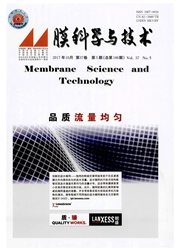

 中文摘要:
中文摘要:
采用硅橡胶(PDMS)/乙酸纤维素(CA)复合膜对甲醛废水溶液进行渗透汽化处理,通过改变料液温度、料液浓度等因素考察其对渗透通量及分离因子的影响.实验结果表明,一定温度范围内,该体系的渗透汽化过程存在一个最佳的分离因子;在研究处理质量分数为19/5甲醛废液时,透过侧压力为13kPa时,在50℃下可以达到最佳的分离效率,此时甲醛的渗透通量可达到110g/(m2·h),分离因子为1.75,但随着透过侧压力的增高,渗透通量线性降低,分离因子降低;料液浓度越高,膜的渗透通量越大,但最佳分离因子几乎没有改变.通过Arhenius关系式,得出该复合膜的表观活化能为27.57kJ/mol.与其它甲醛废水分离方法相比,渗透汽化法具有设备简单,操作方便,费用低廉等特点,为工业化的应用提供了新的技术尝试.
 英文摘要:
英文摘要:
A experimental research for separating formaldehyde wastewater by pervaporation with PDMS/ CA composite membranes was carried out . The effects of feed temperature and feed concentration of formaldehyde aqueous solution on the permeation flux and separation factor of formaldehyde was investigated thoroughly. The results indicate that there is an optimal separation factor for pervaporation process over a range of temperatures. When dealing with formaldehyde wastewater with feed concentration of 1% at 50 ℃ and under permeation pressure of 13 kPa, this composite membrane has a excellent separation efficiency with up to 110 g/(m2 · h)of flux and up to 1.75 of separation factor. Under this condition, permeation flux decreases linearly and separation factor also reduces when the permeation pressure increases. Besides, the higher the concentration is, the larger the permeation flux is, but there is no obvious change on the separation factor. An apparent activation energy of 27. 57 kJ/mol for the composite membrane could also been achieved by Arrhenius equation and the calculated value is considered as 27. 57 kJ/mol. Compared with other methods of separating formaldehyde wastewater, pervaporation has such many advantages as simple equipment, convenient operation and low cost , which can offer a new and effective technical attempt for industrial application of formaldehyde wastewater treatment.
 同期刊论文项目
同期刊论文项目
 同项目期刊论文
同项目期刊论文
 Permeability and Selectivity of Sulfur Dioxide and Carbon Dioxide in Supported Ionic Liquid Membrane
Permeability and Selectivity of Sulfur Dioxide and Carbon Dioxide in Supported Ionic Liquid Membrane Sugar Acetates as CO2-philes: Molecular Interactions and Structure Aspects from Absorption Measureme
Sugar Acetates as CO2-philes: Molecular Interactions and Structure Aspects from Absorption Measureme Partitioning of drug model compounds between poly(lactic acid)s and supercritical CO2 using quartz c
Partitioning of drug model compounds between poly(lactic acid)s and supercritical CO2 using quartz c 期刊信息
期刊信息
